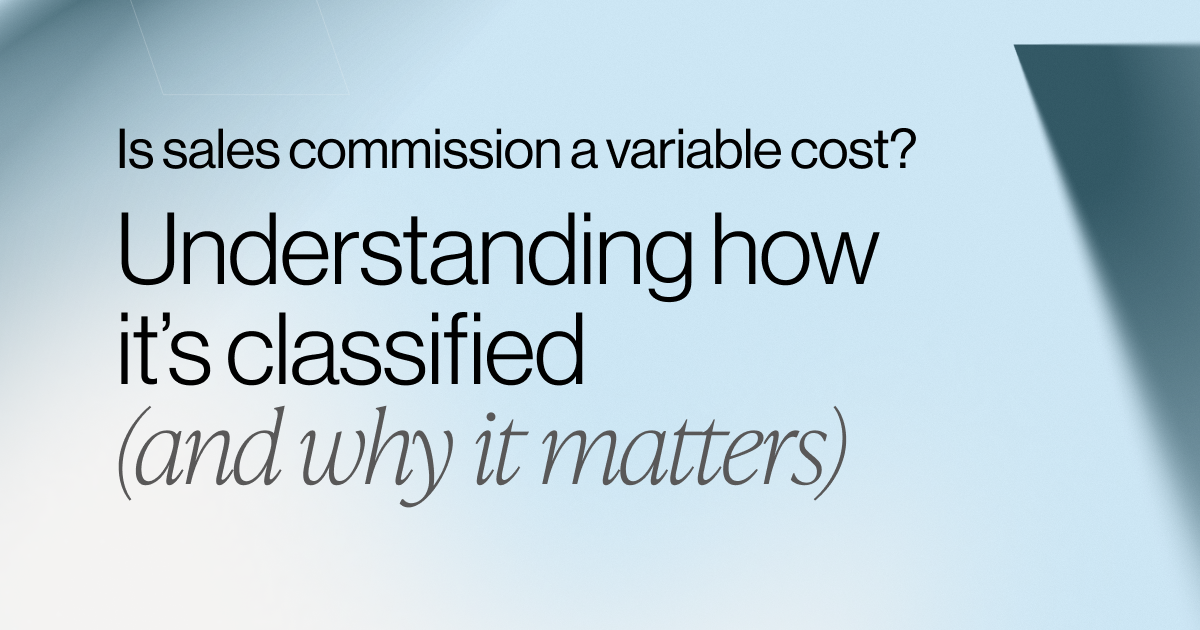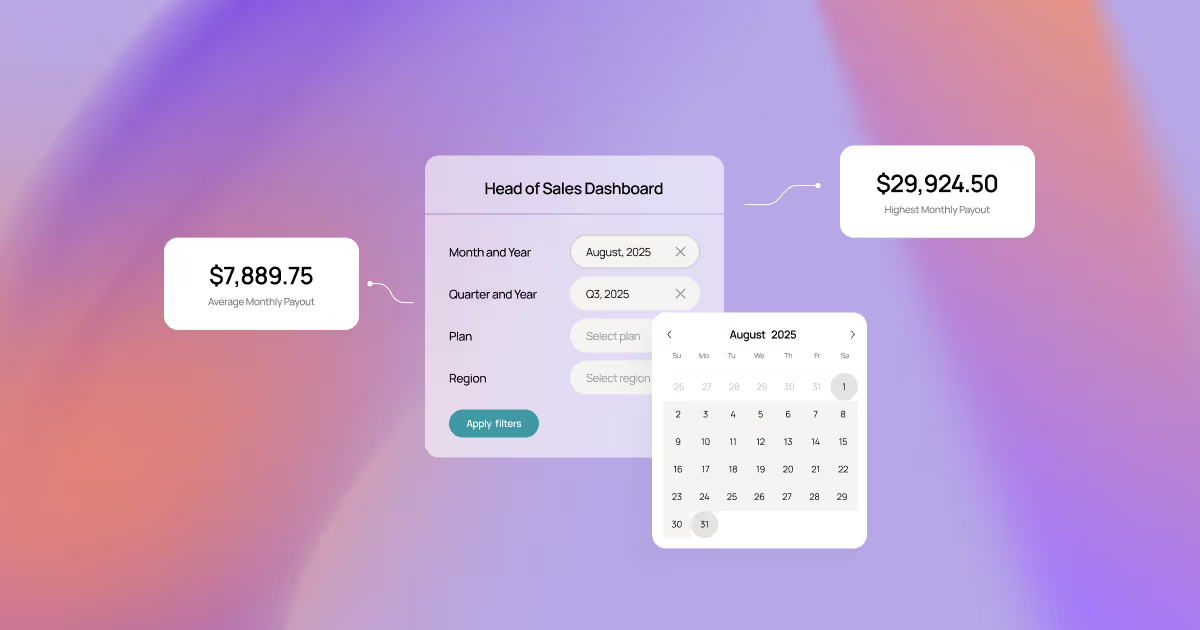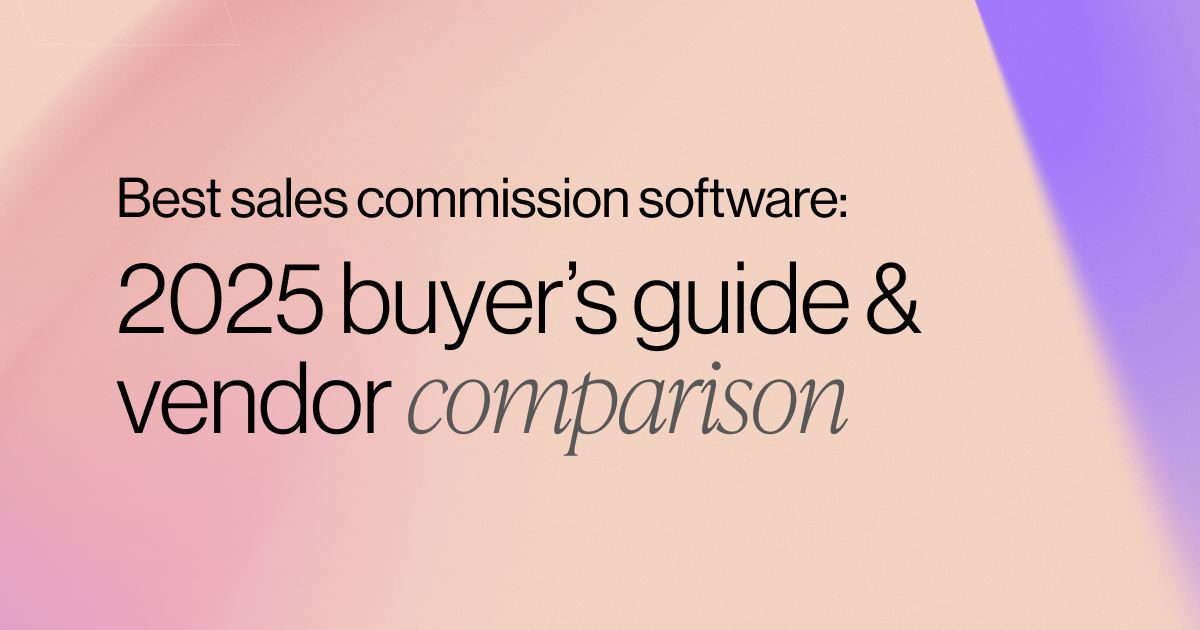Decoding Commission Structures: What's the Right Sales Compensation Structure for You?
Sales commission structures are an element of sales variable pay that help determine how reps are paid and the rules and regulations for how and when a salesperson gets compensated.
The commission structure will often include information about:
- Commission rates and payment terms
- When sales commission payments are due
- What type of activity qualifies for commission and/or which behaviors will salespeople be rewarded for
- Who has the authority to approve commission payments
- Guidance on when commission payments should be withheld or refunded
A commission structure can also be used to incentivize individual performance or collective results by providing additional bonuses or rewards for helping others reach their goals. All in all, it's a means for businesses to motivate their teams!
Sales leaders develop and evolve compensation structures, strategies, and plans to attract, retain, and motivate top performers and accomplish critical goals.
When administered correctly, sales commission structures help reps stay focused on the proper outcomes and align compensation plans with evolving market and business requirements.
A traditional sales compensation plan consists of two main components:
- Fixed pay: A set amount paid each month regardless of how a rep sells. Most common example: base salary.
- Variable pay: Payment calculated based on performance metrics or goals. Most common examples: commissions (typically a percentage of a rep’s monthly or quarterly sales) and bonuses.
This article will cover the ins and outs of sales commission structures: how they work, the most common types, a few best practices, and some common industry rates. We’ll also weave in some real-life examples.
What are the most common sales commission structures?
Many companies use variable pay as a tool for motivation because reps can earn more when they model key behaviors and achieve specific levels of sales output. However, before motivating your sales team to close deals, you must figure out which commission structures will work best for them and the business.
Spoiler alert: No singular, one-size-fits-all, “typical” sales commission structure exists.
There are a few basic structures, however, that are more common in businesses. Let's take a closer look at three common commission structures.
1. Straight Commission
For sales reps with a straight commission structure, 100% of earnings come from sales (no baseline pay is guaranteed).
For example, let’s say a sales rep has a commission rate of 40% on revenue generated and brings in $800,000 in revenue for the year. His compensation would be $320,000 for the year (i.e., 40% of $800,000).
Some companies implement a straight commission structure for full-time reps, but they usually require reps to hit a minimum amount of sales before they can receive this type of payout.
Straight commission models work best for:
- Newer businesses or early-stage startups that are not yet equipped to hire full-time employees. A straight commission structure means that sales reps are classified as independent contractors.
- Industries with contingent sales, such as real estate or retail.
- Sales reps who want full control over their work hours and the amount they can make.
- Referral programs with affiliate marketers, contractors, and external sales partners.
In a straight commission model, the percentage awarded to a sales rep is often higher than for companies that offer a base salary plus commission. This higher percentage can appeal to sales reps confident in their ability to sell your product or service, often drawing in the best of the best talent.
You’ll often hear polarizing responses from sales reps who strongly prefer the base pay plus commission model or the straight commission model. Those who value stability usually prefer the former, while those who prefer to feel 100% in control of their financial destinies often prefer the latter.
2. Base Salary Plus Commission
The base rate plus commission model is often a preferred (and popular) approach as it guarantees salespeople will make something (a base salary). Plus, reps earn additional compensation based on their sales or fixed commission rates.
For example, let’s say you’re offering a base salary of $100,000 and a fixed rate commission of 10% on revenue generated by the sales rep. If a sales rep generates $200,000 in revenue, she would earn $20,000 in revenue and receive total compensation of $100,000 (base) plus $20,000 (fixed rate commission) for that year.
Base salaries enable your sales reps to make some guaranteed earnings, regardless of sales performance, providing them with stability and leading to lower employee churn. The extra commission gives sales reps an incentive to push your product or service.
At first glance, you may think that the benefit of lower churn isn’t all that meaningful. However, according to the Bureau of Labor Statistics, the average annual turnover rate is 47% across all industries. Annual turnover rates vary greatly by industry and region: the leisure and hospitality industry is most at risk with an average of 86%, coming in a close second is professional and business services (64%), and then construction (56%).
Now, ask yourself how long it takes the average employee to get fully onboarded to your team and subtract that from one and a half years. Additionally, ask yourself how effective team members are in their first year on the job. A bit alarming, isn’t it?
If you’re convinced that offering a base salary is right for your team, you may want to consider making the base salary consistent with the market average. This helps ensure that sales reps are still motivated to strive for commissions and not become complacent with their base pay.
Further, follow a 60:40 base salary-to-commission ratio. According to Indeed, this is the standard ratio, with 60% being the base rate and 40% being commission-driven.
The base salary plus commission structure is best for:
- Established businesses that want to reduce turnover
- Industries such as technology, manufacturing, and insurance
3. Tiered Commission
A tiered commission structure allows companies to recognize top performers and push sales reps further by adding incremental goals with even higher payouts. There’s also the added benefit of leveraging a quota system to ensure that sales reps produce a minimum amount of value for your business.
With a tiered commission structure, sales reps earn a set commission percentage on their sales.
For each level (or “tier”) a rep achieves, the more commission they can earn. For example, say an employee’s commission rate is 5% for the first $10,000 in sales. Once they reach $10,000, that commission rate jumps to 10%, incentivizing the sales rep to try to make at least $10,000 worth of sales. This model incentives reps to boost their sales and raise their commission.
A somewhat more punitive way to structure tiered commissions is to reduce the commission earned on any amount less than the desired quota. For example, if the quote for Henry is $10,000 but he sells $8,000 (i.e., 80% of his quota), then the company may choose to pay him only 80% of his commission.
The tiered commission structure is best for:
- Growth-driven businesses where revenue is the top priority, and awarding incremental sales within a period is preferred.
- Teams that want each sales rep to secure a minimum amount of sales.
As noted, the main advantage of this structure is to encourage (and incentive) reps to meet, then blow through their sales numbers.
Additional commission structures worth noting
While these are the most common sales commission structures, the following also are used by sales teams:
- Relative Commission Plan: Earnings are proportional to how much of quota is obtained.
- Territory Volume Commission Plan: Earnings are based on what a team closes in a pre-assigned territory.
- Recoverable Draw Against Commission Plan: Commission is paid in advance — when the sales period ends, what remains is deducted from the rep's total earned commissions.
- Residual Commission: Commission is earned on an ongoing basis — as an account grows in value, the sales rep makes more money.
- Gross Margin Commission: When determining commission, expenses are factored in — reps earn a percentage of the profit. As a result, salespeople are less likely to discount products and more likely to upsell.
- Hybrid Commission: Combines two different commission models, such as straight and tiered. It combines elements from both to create a new system that works best for the company's particular situation.
- Team Commission: Rewards reps not only for their individual performance but also for how well they work with others in their team. This encourages collaboration and gives teams more incentive to work together to hit targets and quotas.
This list is far from complete.
No matter which one (or two or three) you choose, the most important thing is ensuring it's fair for all parties involved and incentivizes your sales reps appropriately. If done correctly, your commission structure can have a huge impact on motivating your team and maximizing their performance.
Sales commission structure best practices
One of the most critical sales commission structure best practices is to be clear about payouts. A transparent sales commission structure helps motivate employees, keeps them “in the loop,” and makes the system fairer.
Speaking of transparency, CaptivateIQ has long enabled reps with a transparent statement experience. However, we recently took rep transparency to the next level. We completely redesigned the visual layout and navigability of CaptivateIQ's statements to enable comp admins more flexibility and customization while delivering a transparent and engaging statement experience that both parties trust and enjoy.
Here are more best practices to keep in mind:
- Clearly define the roles and responsibilities of each participant in the sales commission structure
- Consider employee tenure, skills, and experience when setting targets (and thereby variable payouts)
- Clarify the company's objectives for implementing a sales commission structure
- Determine how the sales commission structure will contribute to meeting those objectives
- Design a sales commission structure that is equitable and motivating for all participants
- Clearly communicate the sales commission structure to all participants
- Take into account regional differences in compensation levels
- Factor in the cost of doing business in different parts of the country
- Don’t be afraid to encourage team selling and reward customer loyalty (if it makes sense to do so)
- Leverage bonuses for exceptional performance
- Periodically review and adjust the sales commission structure to ensure it's still working as intended
And always remember: As business needs change over time, so too should commissions — ensuring both the company and its employees remain satisfied.
Sales commission rates in major industries
Sales commission rates can vary significantly from industry to industry. Here is a short breakdown of some of the most common sales commission rates by industry.
Construction
Sales commission rates for construction can also vary greatly depending on the specific company, project, etc.
However, according to Remodeling by JLC, most fall between 1% and 10%. The variation depends on the sales commission structure used (see above).
Manufacturing
RepHunter reported that most manufacturers' sales rep commission rates are between 7% and 15%. However, like construction, the rates can be much higher or lower depending on the company and the structure they use.
Staffing and Recruiting
Staffing and recruiting is another industry that frequently uses a sales commission structure for employees. For example, Betterleap reports that recruiters typically receive 30-60% of the placement fee charged to the company for employees they recruit.
Independent sales reps are also reasonably common in the staffing and recruiting industry, and the independent sales rep commission rate is typically 5% to 15%, according to Zen Business.
Retail
Launch Grow Joy says the average commission for retail sales clothing is 15%. The average commission rate for retail sales is similar, usually between 20-30%, according to MapMyCustomers.
How CaptivateIQ fits into the sales commission structure puzzle
Commission structures are one of the biggest and most powerful tools to motivate sales teams.
Whether a SaaS business or a car manufacturer, you'll likely experiment to learn what’s effective at motivating your team. A commission rate is not a “set and forget” — it must adjust as your team and business environment evolves.
According to some research we recently performed, nearly two-thirds (60%) of sales managers have made compensation plan adjustments in recent months, and most are thinking ahead of the curve.
Additionally, compensation planning is positively linked to success. Firms are 4x more likely to achieve sales objectives if they plan effectively. Yet while most firms (88%) consider compensation planning as instrumental to their success, only 40% are good at it.
CaptivateIQ can help fill these gaps.
Incentive compensation is your organization's most impactful go-to-market investment, influencing more revenue than any other business lever — if managed effectively. CaptivateIQ gives you control over this strategic lever, enabling you to systematically design, deploy, and adapt compelling commission plans.
Read our most recent guide covering sales commission structure for actionable insights, best practices, and benchmarks to help you get the most out of your incentive compensation program.
Note: This content is for informational purposes only and should not be construed as financial, accounting, tax, legal, or compliance advice or guidance. Please consult a professional adviser for guidance on your specific situation.
.svg)








